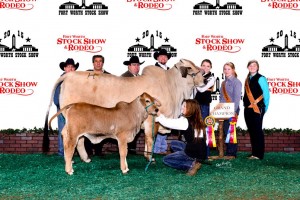Despite Looks, Brahman Cattle Are As Tough As They Come
~Article as posted by The Star-Telegram

Stock Show visitors in the cattle barns Tuesday ooohed at the size of Brahman guys like Mr. Elijah Manso, a gray 2,500-pounder, and aaaahed at the tender sight of Lady H Alexis Manso nursing her 2-month-old bull calf.
Brahmans are superheroes at survival against heat, drought, humidity, insects and poor range conditions, and their traits are influencing cattle breeding in the 21st century.
“Now that weather is getting more extreme, it’s the most adaptive breed,” said 20-year Brahman raiser Carlos Reyes of Tampico, Mexico, owner of Lady Alexis. He exhibited five heifers in addition to Lady Alexis and her unnamed calf at the American Brahman Breeders Association open show Tuesday.
Reyes’ ranch in Mexico is named Tres Mujeres in honor of his wife and two daughters.
The animals were bred and shown by Heritage Cattle Co. of Hungerford.
Lady Alexis won grand champion female.
What makes a great bull like Elijah stand out in the show ring?
“It’s the genetics, the way he’s built,” said his owner, Michael Navarro of MN Ranch in Cotulla. “He’s big-boned, big-gutted, big-footed. That’s well-liked by breeders all over.”
Elijah is almost 3 years old, and his 2014 wins include grand championships in the Jambalaya Classic, the All-American Show and the Heritage Classic Show, and reserve grand championships in the ABBA National Show and the Louisiana Sugar Classic.
Elijah won reserve senior champion bull Tuesday.
The last name Manso appears on Brahman cattle descended from a literal granddaddy of the Brahman breed, a gray bull named Manso who lived on the J.D. Hudgins ranch in Hungerford, near Houston.
The commercial cattle ranch was established in 1908 when J.D. Hudgins and his children began buying humpbacked Indian cattle from neighbors in an attempt to breed cattle tough enough for the challenges of the Gulf Coast environment.
By 1924, the American Brahman breed registry had been established. And in 1933, the Hudginses bought Manso, a “banana-horned” bull prized for his conformation, size and disposition. The first of Manso’s lifetime total of 316 calves was born in 1934, and the American Brahman Breeders Association estimates that 75 percent of cattle it registers today are from Manso’s line.
Manso died at age 17 in 1943. The latest Brahman buzzword is F1, Reyes and Navarro say.
The designation refers to cattle resulting from the trend of crossbreeding Brahmans with European and other breeds to create stronger, more adaptive animals.
Average visitors to the Brahman barn had more mundane questions for the breeders and owners, such as, “What’s the purpose of the hump, and what’s stored in there?”
Answer: meat. “It’s just part of the breed, one of the distinctive things about them,” Reyes said. “They’re the most beautiful animals.”



 GANADERIA TRES MUJERES
GANADERIA TRES MUJERES